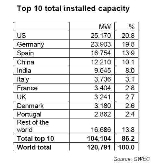Wind Installations Continue To Break Records Across the Globe
According to new a new report from the Global Wind Energy Council (GWEC), as of 2008 the U.S. has become the world's largest player in terms of total wind power installations.
"These figures speak for themselves: there is huge
and growing global demand for emissions-free wind power, which can be
installed quickly, virtually everywhere in the world."
-- Steve Sawyer, Secretary General, Global Wind Energy Council
Global wind capacity grew by almost 29% to reach close to 121 GW at the end of 2008 while the global wind market for turbine installations for the year was worth about €36.5 billion [US $47.5 billion].
As RenewableEnergyWorld.com reported last week, the U.S. wind energy industry shattered all previous records in 2008 by installing 8358 MW of new generating capacity, according to the American Wind Energy Association (AWEA).
Increasing total installed wind capacity by 50%, AWEA says the combined development channeled investment of some US $17 billion into the economy.
The share of domestically manufactured wind turbine components has grown from under 30% in 2005 to about 50% in 2008 and manufacturers announced, added or expanded 70 new facilities in the past two years, including more 55 in 2008.
However, warning of an uncertain outlook for 2009 due to the continuing financial crisis, AWEA noted that, towards the end of the year, financing for new projects and orders for turbine components slowed to a trickle and layoffs began to hit the wind turbine manufacturing sector.
Nonetheless, with a total installed capacity of 25 GW installed, the U.S. has now officially overtaken Germany, with 24 GW of wind.
Statistics released this week by the European Wind Energy Association (EWEA) show that 43% of all new electricity generating capacity built in the European Union last year was wind energy, more than all other technologies, including gas, coal and nuclear power.
In 2008, a total of 19,651 MW of new generating capacity was installed across the economic bloc. Of this, 8484 MW was wind, 6932 MW of gas with a 35% share, 2495 MW of oil, a 13% share and 4%; 762 MW of coal.
A total of 64,949 MW of wind capacity was operating in the EU by the end of 2008, 15% higher than in 2007 and a total of some 160,000 workers were employed directly and indirectly in the sector. Investments in the sector came in at about €11 billion in the EU as a whole in 2008.
Germany has a narrow lead, with 1665 MW installed against Spain's 1609 MW. In 2008 Italy added 1010 MW to reach a total of 3736 MW; France 950 MW to reach 3404 MW and the UK, 836 MW to reach 3241 MW. EWEA says that, overall, 2008 saw a much more balanced expansion led by France, the UK and Italy, part of a "second wave" of countries that are providing real momentum to the surge in wind energy. Together with the Netherlands, Portugal, Sweden and Ireland, ten EU Member States — over one-third — now have more than 1000 MW each. Austria and Greece follow close behind with 995 MW and 985 MW respectively. (View the charts below, which show the top 10 countries for installed capacity and for new capacity in 2008.)
 |
 |
Furthermore, a distinct "third wave" became visible for the first time in 2008 as the new Member States had their strongest year ever, EWEA says. Hungary doubled its capacity to 127 MW and Bulgaria tripled its capacity from 57 MW to 158 MW. Poland, one of the fastest growing younger markets, now has 472 MW up from 276 MW. Outside the EU Member States, Turkey tripled its wind energy capacity from 147 MW to 433 MW.
In terms of offshore wind energy, 357 MW of capacity was added in 2008, to reach a total of 1471 MW. Nearly 2.3% of total installed EU capacity is now offshore.
Christian Kjaer, EWEA chief executive, observed: "The figures show that wind energy is the undisputed number one choice in Europe's efforts to move towards clean, indigenous renewable power."
He added: "Wind energy is an example of an intelligent investment that puts EU citizens' money to work in their own economies rather than transferring it to a handful of fuel-exporting nations."
With close to a third of all new capacity in 2008 installed in Asia, China also added about 6.3 GW, reaching a total of over 12 GW installed. China's total capacity doubled for the fourth year in a row and in its response to the financial crisis, the Chinese government has identified the development of wind energy as one of the key economic growth areas.
"These figures speak for themselves: there is huge and growing global demand for emissions-free wind power, which can be installed quickly, virtually everywhere in the world," said Steve Sawyer, secretary general of Global Wind Energy Council (GWEC).
"The 120 GW of global wind capacity in place at the end of 2008 will produce 260 TWh and save 158 million tonnes of CO2 every year," he continued.
GWEC's chairman, Professor Arthouros Zervos said, "Wind power is often the most attractive option for new power generation in both economic terms and in terms of increasing energy security, not to mention the environmental and economic development benefits. The wind industry also creates many new jobs: over 400,000 people are now employed in this industry, and that number will be in the millions in the near future."
 To subscribe or visit go to:
http://www.renewableenergyaccess.com
To subscribe or visit go to:
http://www.renewableenergyaccess.com